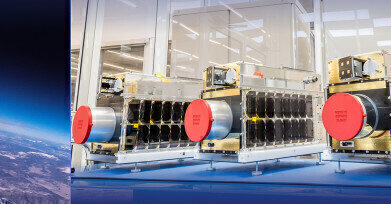-
 GHGSat Constellation Launch 2022 (image credit made to Space Flight Laboratory)
GHGSat Constellation Launch 2022 (image credit made to Space Flight Laboratory)
Air Monitoring
New optical sensors to double methane monitoring capabilities for GHGSat in space
Jul 13 2022
GHGSat are a Canadian company who specialise in high-resolution greenhouse gas (GHG) monitoring from space. They recently launched three new optical sensors, manufactured by ABB, into space aboard a SpaceX Falcon 9 rocket which set off from Cape Canaveral, thus doubling their methane gas emission monitoring capabilities.
GHGSat’s provide hyperspectral imaging technology that precisely locates and monitors methane emissions from any industrial location on Earth. The launch of ABB’s high-resolution methane sensors has doubled the GHGSat’s capability to observe customer sites for methane emissions. In addition to the three units named Luca, Penny and Diako, there will be five additional methane measurement units which are currently being assembled at ABB.
Space is the only place where emissions can be monitored freely across international boundaries and reported on to facilitate actions to reduce pollution levels. Measuring each location with the same sensor means that emissions can be compared accurately and consistently. Measurements taken from space offer an ideal solution for locations where ground sensors are economically unviable, or deployment is too complex.
The constellation contract between GHGSat and ABB was announced in October 2020, with the first delivery made the following year. The launch of the additional devices boosts GHGSat’s lead as operators of the world’s largest in-orbit constellation dedicated to GHG emission monitoring.
The International Energy Agency have stated that methane is responsible for approximately 30% of the rise in global temperatures since the Industrial Revolution. Therefore, fast and sustained reductions in methane emissions are crucial to lowering near-term global warming and improving air quality across the globe.
For over 20 years, having been involved with the Canadian SCISAT mission as well as Japan’s GOSAT satellites program, ABB has been at the pinnacle of greenhouse gas sensing from space. ABB’s optical devices that are already operating outside of the Earth’s atmosphere have accumulated over 100 years of successful and dependable operation. Their SCISAT sensor monitors long-term compositional changes in the Earth’s atmosphere, collating data from otherwise indistinct atmospheric changes and detecting pollutants to parts per trillion levels.
ABB sensor technology is widely relied upon by weather agencies across the globe including the US National Oceanographic and Atmospheric Administration (NOAA), who have installed ABB sensors on their NPP and JSS satellites to improve accuracy and speed of their weather forecasting capabilities thus helping to save lives and protect communities.
Digital Edition
AET 28.2 April/May 2024
May 2024
Business News - Teledyne Marine expands with the acquisition of Valeport - Signal partners with gas analysis experts in Korea Air Monitoring - Continuous Fine Particulate Emission Monitor...
View all digital editions
Events
Jul 30 2024 Jakarta, Indonesia
China Energy Summit & Exhibition
Jul 31 2024 Beijing, China
2024 Beijing International Coal & Mining Exhibition
Aug 07 2024 Beijing, China
IWA World Water Congress & Exhibition
Aug 11 2024 Toronto, Canada
Aug 25 2024 Stockholm, Sweden and online








.jpg)








